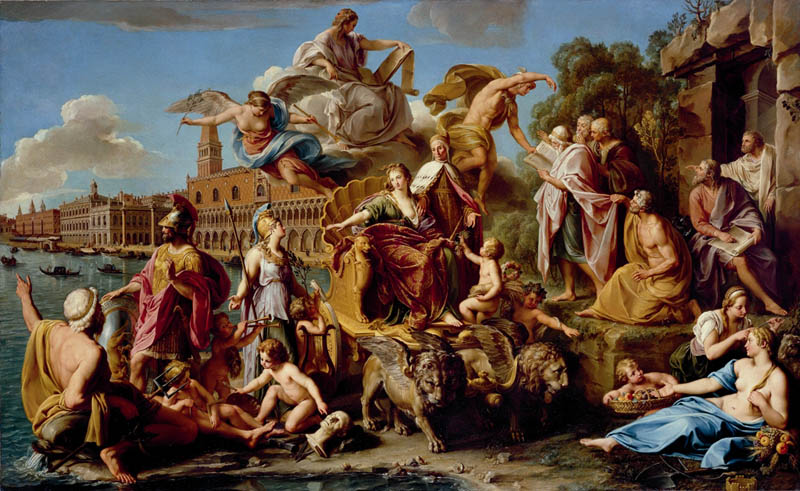The Triumph of Venice (work of art)
Información sobre la obra de arte
Key Ideas
- This neoclassical painting depicts an outdoor scene on the bank of the Grand Canal in Venice, Italy. It celebrates the city’s progress in art in the 16th century and its place in history in the 18th century.
- The woman sitting in the carriage symbolizes the city of Venice. The artist used personification to represent the city as a person.
- Pompeo Batoni was an Italian artist who painted portraits and detailed scenes from Roman mythology. In this painting he depicted Venice (as a woman) reaching out to Minerva, the Roman goddess of wisdom and art.
- A former governor of the city of Venice is also depicted in this scene. He is shown standing behind Venice’s carriage with his hand resting on her shoulder. Many famous Venetian works of art were created during his leadership.
Más información
The Triumph of Venice is a neoclassical painting that was commissioned by a Venetian ambassador to Rome. Neoclassicism was a cultural movement in the 18th and 19th centuries. Art and architecture inspired by ancient Greece and Rome became popular during that time.
This scene celebrates the art made in Venice in the early 16th century. It also celebrates the city’s importance as a stop on the Grand Tour during the 18th century. The Grand Tour was considered to be a rite of passage for wealthy young European men. During their tour the men studied ruins, cities, landscapes, and artworks throughout Europe. The city of Venice was an essential part of the tour because many classical buildings and artworks are located there.
Italian artist Pompeo Batoni painted portraits and sold them to the “grand tourists” who visited Venice. He also created allegorical paintings and scenes from Roman mythology. One of the mythological figures he featured in this painting is Minerva. She was the Roman goddess of wisdom and art. She was also known as the goddess of industry, commerce, schools, and later, war. In this scene Minerva is standing beside a carriage pulled by winged lions, and the woman in the carriage is reaching out to her. The seated woman represents the city of Venice. This is an example of personification in a painting. The artist portrayed a nonhuman thing (a city) as having human traits and a human body.
Lionardo Loredan, a former governor of the city Venice, is also depicted in this scene. He is shown standing behind Venice, with his hand on her shoulder. Many famous works of art were created in Venice during Loredan’s reign in the early 16th century. These works gained popularity in the 18th century.
Recursos adicionales
Recursos para los profesores
- Read an essay about the Grand Tour.
- Explore a website that features Venice as a stop on the Grand Tour.
- Read an essay about neoclassicism.
- Review a lesson plan for ideas on teaching students to use personification in their art.
Recursos para los estudiantes
- Look closely at another painting of Venice that was considered to be a Grand Tour souvenir.
- View another work by Batoni with classical influences.
- Read an article about Venetian art.

